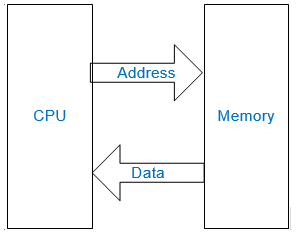Quiz #1 Review
Note: Answers are listed after each question but, for the best study experience always answer them on your own first.
- With respect to the functional layout of data and program memory, which architecture, Charles Babbage’s mechanical Analytical Engine designed in 1833 or Dr. John Von Neumann’s electronic EDVAC computer designed over 100 years later in 1943, most closely resemble the AVR and why?
[expand title=”See Answer” tag=”h5″]
The Analytical Engine designed in 1833 and the EDVAC designed in 1943 have the same five (5) principle organs that make up all modern day computers (Control, ALU, Memory, Input, and Output). Functionally, the main difference, other than the names given to each organ by Charles Babbage and Dr. Von Neumann, is the way data and instructions are stored. The Analytical Engine has a separate set of punched cards for data and the program. In contrast, both data and programs are stored together within the EDVAC’s ultrasonic delay line memory. Like the Analytical Engine, the AVR architecture separates Flash program and SRAM data memory and therefore is more like the Analytical Engine. Today this is known as the Harvard Memory Model.
[/expand]
2. What is the address of the last byte in memory of a computer system with an 18-bit address bus and an 8-bit data bus?
[expand title=”See Answer” tag=”h5″]
Range of addresses is to
[/expand]
3. What is the maximum number of characters that can be represented by an 8-bit code?
[expand title=”See Answer” tag=”h5″]
characters
[/expand]
4. What is the largest unsigned number, in decimal, that can be held in an 8-bit register?
[expand title=”See Answer” tag=”h5″]
[/expand]
5. What is the range of signed 2’s complement numbers, in decimal, that can be held in an 8-bit register?
[expand title=”See Answer” tag=”h5″]
to
[/expand]
6. Convert to binary and hex.
[expand title=”See Answer” tag=”h5″]
x
x
[/expand]
7. Convert to decimal.
[expand title=”See Answer” tag=”h5″]
[/expand]
8. Perform the hex subtraction 36Bh – F6h.
[expand title=”See Answer” tag=”h5″]
[/expand]
9. Applying DeMorgan’s Theorem and the Basic Laws and Theorems of Boolean Algebra; simplify the following expressions:
[expand title=”See Answer” tag=”h5″]
=
=
[/expand]
10. Complete the timing diagram for the following edge triggered D Flip-Flop. Q is initially at logic .
[expand title=”See Answer” tag=”h5″]
[/expand]
11. Assuming a 64-bit computer, for example the Intel Itanium microprocessor; place the following terms in ascending order relative to the number of binary digits they represent (Nibble, Word, Bit and Byte).
[expand title=”See Answer” tag=”h5″]
Bit, Nibble (4 bits), Byte (8 bits), Word (64 bit architecture)
[/expand]
12. Which register in a CPU always contains an address?
What address is contained in this register?
[expand title=”See Answer” tag=”h5″]
Program Counter (PC).
The program counter holds the address of the next instruction to be executed.
[/expand]
13. During an opcode fetch, what is the information on the address and data buses?
What is the direction of information flow on these buses during an opcode fetch?
[expand title=”See Answer” tag=”h5″]
The address bus contains the address of the next instruction to be executed (i.e. the contents of the program counter). The data bus then contains the actual instruction (i.e. the opcode) fetched from memory.
[/expand]
14. The sole purpose in life of a computer is to do what?
[expand title=”See Answer” tag=”h5″]
The sole purpose in life of a computer is to fetch and execute instructions.
[/expand]
15. The Arduino Uno Board uses the Atmel Atmega328P microcontroller. Use the web to complete the following table.
| Feature | ATtiny24 | ATmega328P | ATmega644P |
| Flash Program Memory | |||
| SRAM Data Memory | |||
| EEPROM | |||
| Timers (8 and 16 bit) | |||
| I/O pins | |||
| Serial peropherals (UART, USART, USI, SPI) | |||
| 10-bit A/D channels |
[expand title=”See Answer” tag=”h5″]
| Feature | ATtiny24 | ATmega328P | ATmega644P |
| Flash Program Memory | 2KBytes | 32KBytes | 64Kbytes |
| SRAM Data Memory | 128 Bytes | 2 KBytes | 4 KBytes |
| EEPROM | 128 | 1 KBytes | 2 KBytes |
| Timers (8 and 16 bit) | 2 | 3 | 3 |
| I/O pins | 12 | 23 | 32 |
| Serial peropherals (UART, USART, USI, SPI) | 2 | 2 | 3 |
| 10-bit A/D channels | 8 | 8 | 8 |
[/expand]
AVR Assembly Language Programming
16. List all AVR ISA (Instruction Set Architecture) registers.
[expand title=”See Answer” tag=”h5″]
Program Counter (PC)
General Purpose Registers R0 thru R31 Status Register (SREG)
Stack Pointer (SP)
[/expand]
17. For the three addressing modes listed, indicate where the data is located and at what address.
| Addressing Mode | Data is located here | ATmega328P Address Space |
| Register | ||
| Immediate | ||
| Direct |
[expand title=”See Answer” tag=”h5″]
| Addressing Mode | Data is located here | ATmega328P Address Space |
| Register | CPU | 0016 – 1F16 (R0 – R31) |
| Immediate | Flash Program Memory | 000016 – 03FF16 |
| Direct | SRAM Data Memory I/O | 000016 to 08FF16
000016 to 003F16 |
[/expand]



